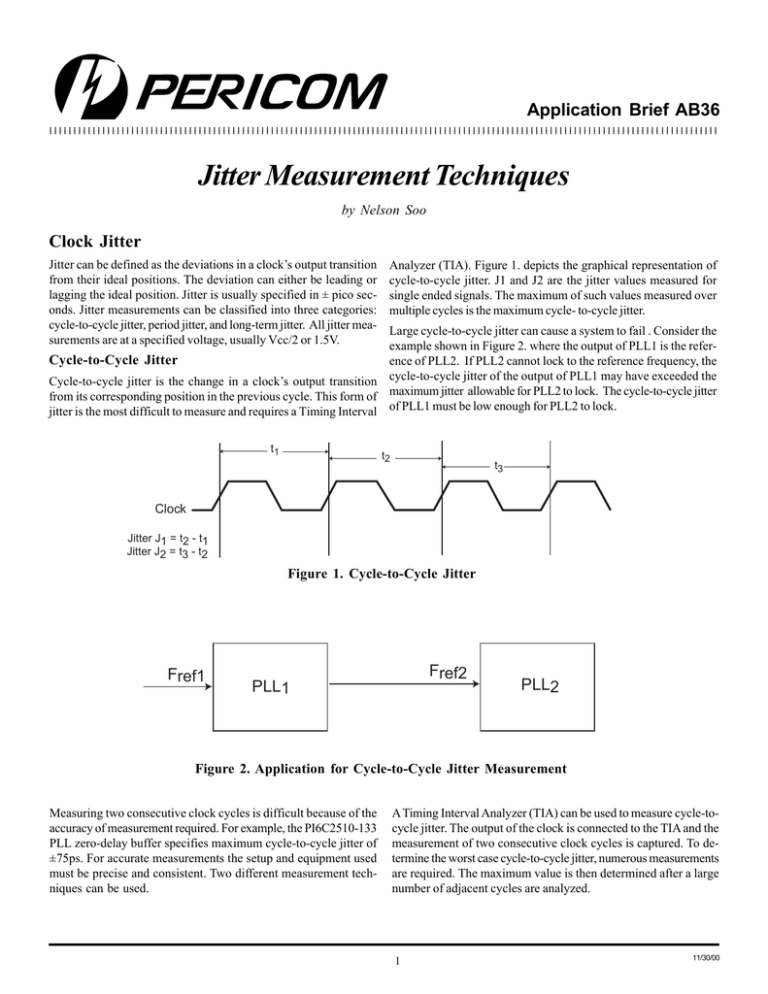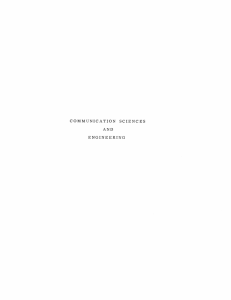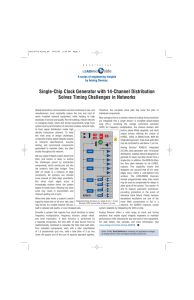Jitter Measurement Techniques
advertisement

Application Brief AB36 12345678901234567890123456789012123456789012345678901234567890121234567890123456789012345678901212345678901234567890123456789012123456789012 12345678901234567890123456789012123456789012345678901234567890121234567890123456789012345678901212345678901234567890123456789012123456789012 Jitter Measurement Techniques by Nelson Soo Clock Jitter Jitter can be defined as the deviations in a clock’s output transition from their ideal positions. The deviation can either be leading or lagging the ideal position. Jitter is usually specified in ± pico seconds. Jitter measurements can be classified into three categories: cycle-to-cycle jitter, period jitter, and long-term jitter. All jitter measurements are at a specified voltage, usually Vcc/2 or 1.5V. Analyzer (TIA). Figure 1. depicts the graphical representation of cycle-to-cycle jitter. J1 and J2 are the jitter values measured for single ended signals. The maximum of such values measured over multiple cycles is the maximum cycle- to-cycle jitter. Large cycle-to-cycle jitter can cause a system to fail . Consider the example shown in Figure 2. where the output of PLL1 is the referCycle-to-Cycle Jitter ence of PLL2. If PLL2 cannot lock to the reference frequency, the Cycle-to-cycle jitter is the change in a clock’s output transition cycle-to-cycle jitter of the output of PLL1 may have exceeded the from its corresponding position in the previous cycle. This form of maximum jitter allowable for PLL2 to lock. The cycle-to-cycle jitter jitter is the most difficult to measure and requires a Timing Interval of PLL1 must be low enough for PLL2 to lock. t1 t2 t3 Clock Jitter J1 = t2 - t1 Jitter J2 = t3 - t2 Figure 1. Cycle-to-Cycle Jitter Fref1 Fref2 PLL1 PLL2 Figure 2. Application for Cycle-to-Cycle Jitter Measurement Measuring two consecutive clock cycles is difficult because of the accuracy of measurement required. For example, the PI6C2510-133 PLL zero-delay buffer specifies maximum cycle-to-cycle jitter of ±75ps. For accurate measurements the setup and equipment used must be precise and consistent. Two different measurement techniques can be used. A Timing Interval Analyzer (TIA) can be used to measure cycle-tocycle jitter. The output of the clock is connected to the TIA and the measurement of two consecutive clock cycles is captured. To determine the worst case cycle-to-cycle jitter, numerous measurements are required. The maximum value is then determined after a large number of adjacent cycles are analyzed. 1 11/30/00 Application Brief AB-36 12345678901234567890123456789012123456789012345678901234567890121234567890123456789012345678901212345678901234567890123456789012123456789012 Period jitter measurements are used to calculate timing margins in systems. For example, a microprocessor-based system in which the processor requires 2ns of a data set-up time. Assume that the clock driving the microprocessor-based system has a maximum of 2.5ns period jitter. In this example, the rising edge of the clock can occur before the data is valid on the data bus. The processor will then be given incorrect data and the system will not operate correctly. This example is shown in Figure 4. The system designer must consider period jitter when calculating the timing margin of the system. Another option is to use a Time Interval software package available from Amherst Systems Inc. with an external scope such as the HP54720D. The scope will capture a large number of cycles (actual number of cycles is limited to the memory size of the scope). The data is then transferred to the computer running the MI software, and the cycle-to-cycle jitter is calculated. Pericom uses the M1 and/or TIA to measure cycle-to-cycle jitter. Period Jitter Period jitter is the maximum change in a clock’s output transition from its ideal position. Figure 3. is a graphical representation of period jitter. Ideal Cycle t3 Clock Jitter Figure 3. Period Jitter Ideal Clock Clock with Jitter Set-Up Time Data Figure 4. Application for Period Jitter Measurement One method of measuring period jitter requires a storage oscilloscope. Trigger on the rising edge of the clock and scroll the display until a rising edge of the clock is displayed. To overlay the rising edges, turn on infinite persistence in the display menu. Rising edges are then overlaid on top of one another. A number of cycles can be specified or a certain time elapsed can be set. The period jitter is simply the band of the rising edge displayed on the scope. effect of a jittery clock is to cause an image to shift from its ideal display position on the screen. This effect is also known as “running” of the screen. To measure long-term jitter, a technique called differential phase measurement is used. The clock is connected to an oscilloscope that has a time-base feature. The scope is set to trigger on the rising edge of the clock. Then, using the delayed time-base feature, the same clock waveform is displayed on the screen. The long-term jitter is the time difference of the first rising edge and the time delayed edge. Long-term Jitter Long-term jitter measures the maximum change in a clock’s output transition from its ideal over a large number of cycles. Figure 5. is a graphical representation of long-term jitter. The actual number of cycles depends on the application and the clock frequency . For PC motherboards and graphics applications, this is usually 10-20 microseconds. For other applications, this number will be different. Jitter Cycle 0 One example of a system affected by long-term jitter is a graphics card driving a CRT. Assume that a pixel of data is specified for the pixel at coordinates (10,24) on the CRT. Because of the long term jitter, this data may drive a pixel at the wrong location (11,28). Since the effect of a jittery clock is consistent over all pixels, the overall Cycle N Figure 5. Long-Term Jitter 2 11/30/00 Application Brief AB-36 123456789012345678901234567890121234567890123456789012345678901212345678901234567890123456789012123456789012345678901234567890121234567890123 123456789012345678901234567890121234567890123456789012345678901212345678901234567890123456789012123456789012345678901234567890121234567890123 Summary A consistent method and precise equipment must be used when measuring clock jitter. Outlined in this app brief is the basic method of measurements to measure cycle-to-cycle jitter, period jitter and long-term jitter. If the engineer/technician follows these basic guidelines, then accurate measurements are achievable. 3 11/30/00




